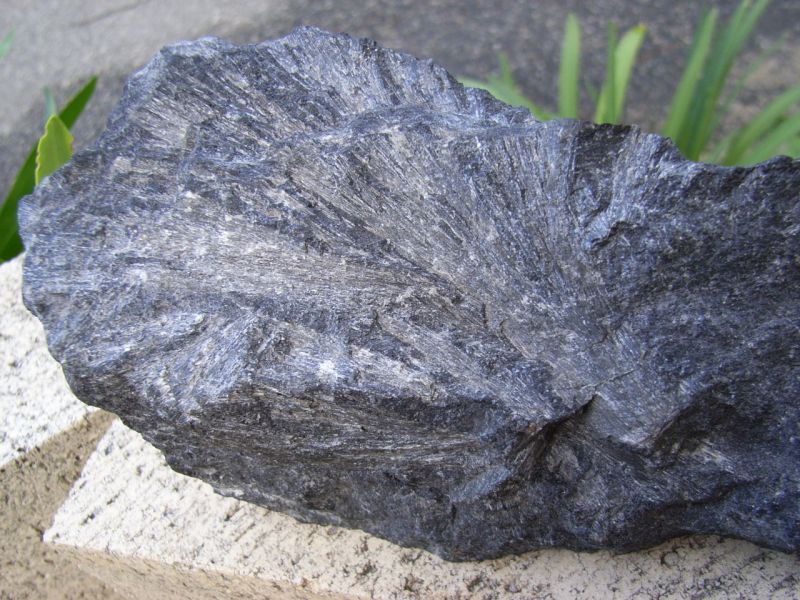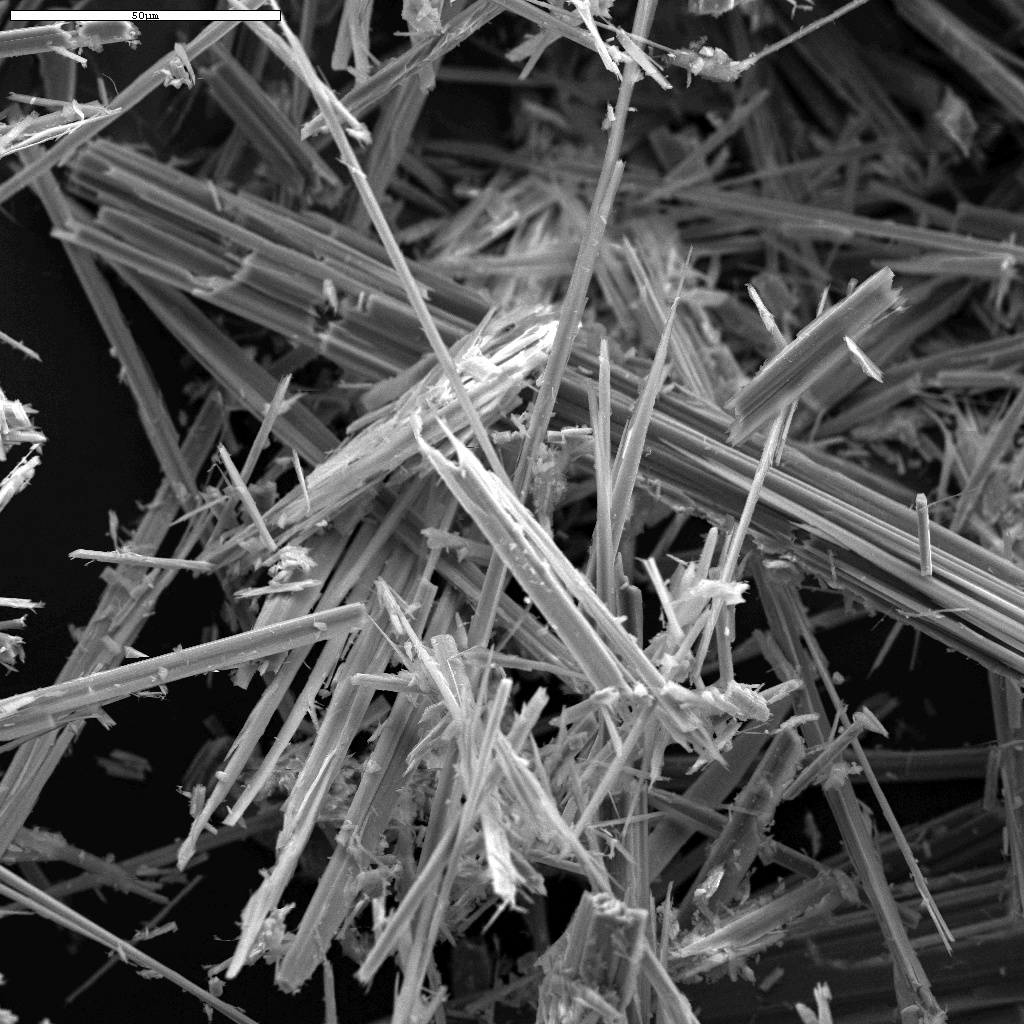anthophyllite on:
[Wikipedia]
[Google]
[Amazon]
Anthophyllite is an orthorhombic amphibole mineral: ☐Mg2Mg5Si8O22(OH)2 (☐ is for a vacancy, a point defect in the crystal structure), magnesium
 Retrogressive anthophyllite is relatively rare in ultramafic rocks and is usually poorly developed due to the lower energy state available for metamorphic reactions to progress and also the general dehydration of rock masses during metamorphism. Similarly, the need for substantial components of carbon dioxide in metamorphic fluid restricts the appearance of anthophyllite as a retrograde mineral. The usual metamorphic assemblage of retrograde-altered ultramafic rocks is thus usually a serpentinite or talc- magnesite assemblage.
Retrograde anthophyllite is present most usually in shear zones where fracturing and shearing of the rocks provides a conduit for carbonated fluids during retrogression.
Retrogressive anthophyllite is relatively rare in ultramafic rocks and is usually poorly developed due to the lower energy state available for metamorphic reactions to progress and also the general dehydration of rock masses during metamorphism. Similarly, the need for substantial components of carbon dioxide in metamorphic fluid restricts the appearance of anthophyllite as a retrograde mineral. The usual metamorphic assemblage of retrograde-altered ultramafic rocks is thus usually a serpentinite or talc- magnesite assemblage.
Retrograde anthophyllite is present most usually in shear zones where fracturing and shearing of the rocks provides a conduit for carbonated fluids during retrogression.
 Fibrous anthophyllite is one of the six recognised types of asbestos. It was mined in
Fibrous anthophyllite is one of the six recognised types of asbestos. It was mined in
iron
Iron () is a chemical element with symbol Fe (from la, ferrum) and atomic number 26. It is a metal that belongs to the first transition series and group 8 of the periodic table. It is, by mass, the most common element on Earth, right in ...
inosilicate hydroxide. Anthophyllite is polymorphic with cummingtonite
Cummingtonite ( ) is a metamorphic amphibole with the chemical composition , magnesium iron silicate hydroxide.
Monoclinic cummingtonite is compositionally similar and polymorphic with orthorhombic anthophyllite, which is a much more common fo ...
. Some forms of anthophyllite are lamellar or fibrous and are classed as asbestos. The name is derived from the Latin word ''anthophyllum'', meaning ''clove'', an allusion to the most common color of the mineral. The Anthophyllite crystal is characterized by its perfect cleavage along directions 126 degrees and 54 degrees.
Occurrence
Anthophyllite is the product of metamorphism of magnesium-rich rocks, especially ultrabasic igneous rocks and impuredolomitic
Dolomite () is an anhydrous carbonate mineral composed of calcium magnesium carbonate, ideally The term is also used for a sedimentary carbonate rock composed mostly of the mineral dolomite. An alternative name sometimes used for the dolomitic ...
shales. It also forms as a retrograde product rimming relict orthopyroxenes and olivine, and as an accessory mineral in cordierite-bearing gneisses and schists. Anthophyllite also occurs as a retrograde metamorphic mineral derived from ultramafic rocks along with serpentinite.
Occurrence in ultramafic rocks
Anthophyllite is formed by the breakdown of talc in ultramafic rocks in the presence of water andcarbon dioxide
Carbon dioxide ( chemical formula ) is a chemical compound made up of molecules that each have one carbon atom covalently double bonded to two oxygen atoms. It is found in the gas state at room temperature. In the air, carbon dioxide is t ...
as a prograde metamorphic reaction. The partial pressure of carbon dioxide (XCO2) in aqueous solution favors production of anthophyllite. Higher partial pressures of CO2 reduces the temperature of the ''anthophyllite-in'' isograd.
Ultramafic rocks in purely hydrous, CO2-free environments will tend to form serpentinite-antigorite
Antigorite is a lamellated, monoclinic mineral in the phylosilicate serpentine subgroup with the ideal chemical formula of (Mg,Fe2+)3Si2O5(OH)4. It is the high-pressure polymorph of serpentine and is commonly found in metamorphosed serpentini ...
-brucite
Brucite is the mineral form of magnesium hydroxide, with the chemical formula Mg( OH)2. It is a common alteration product of periclase in marble; a low-temperature hydrothermal vein mineral in metamorphosed limestones and chlorite schists ...
- tremolite assemblages (dependent on MgO content) or at amphibolite to granulite metamorphic grade, metamorphic pyroxene or olivine. Thus, metamorphic assemblages of ultramafic rocks containing anthophyllite are indicative of at least greenschist facies metamorphism in the presence of carbon dioxide bearing metamorphic fluids.
The typical metamorphic assemblage reactions for low-magnesian (<25% MgO) and high-magnesian (>25% MgO) ultramafic rocks are;
* Olivine + Tremolite + Talc → Olivine + Tremolite + Anthophyllite (low MgO, >550 °C, XCO2 <0.6)
* Talc + Tremolite + Magnesite → Tremolite + Anthophyllite + Magnesite (High MgO, >500 °C, XCO2 >0.6)
* Talc + Magnesite + Tremolite → Anthophyllite + Tremolite + Magnesite (Low MgO, >500 °C, XCO2 >0.6)
 Retrogressive anthophyllite is relatively rare in ultramafic rocks and is usually poorly developed due to the lower energy state available for metamorphic reactions to progress and also the general dehydration of rock masses during metamorphism. Similarly, the need for substantial components of carbon dioxide in metamorphic fluid restricts the appearance of anthophyllite as a retrograde mineral. The usual metamorphic assemblage of retrograde-altered ultramafic rocks is thus usually a serpentinite or talc- magnesite assemblage.
Retrograde anthophyllite is present most usually in shear zones where fracturing and shearing of the rocks provides a conduit for carbonated fluids during retrogression.
Retrogressive anthophyllite is relatively rare in ultramafic rocks and is usually poorly developed due to the lower energy state available for metamorphic reactions to progress and also the general dehydration of rock masses during metamorphism. Similarly, the need for substantial components of carbon dioxide in metamorphic fluid restricts the appearance of anthophyllite as a retrograde mineral. The usual metamorphic assemblage of retrograde-altered ultramafic rocks is thus usually a serpentinite or talc- magnesite assemblage.
Retrograde anthophyllite is present most usually in shear zones where fracturing and shearing of the rocks provides a conduit for carbonated fluids during retrogression.
Fibrous anthophyllite
 Fibrous anthophyllite is one of the six recognised types of asbestos. It was mined in
Fibrous anthophyllite is one of the six recognised types of asbestos. It was mined in Finland
Finland ( fi, Suomi ; sv, Finland ), officially the Republic of Finland (; ), is a Nordic country in Northern Europe. It shares land borders with Sweden to the northwest, Norway to the north, and Russia to the east, with the Gulf of Bot ...
and also in Matsubase, Japan where a large-scale open-cast asbestos mine and mill was in operation between 1883 and 1970.
In Finland anthophyllite asbestos was mined in two mines, the larger one Paakkila in the Tuusniemi commune started in 1918 and closed in 1975 due to the dust problems. The smaller mine, Maljasalmi in the commune of Outokumpu, was mined from 1944 to 1952. The anthophyllite was used in asbestos cement and for insulation, roofing material etc.
Anthophyllite is also known as azbolen asbestos.
References
{{Commons category, Anthophyllite Amphibole group Magnesium minerals Iron minerals Asbestos Orthorhombic minerals Minerals in space group 62 Luminescent minerals